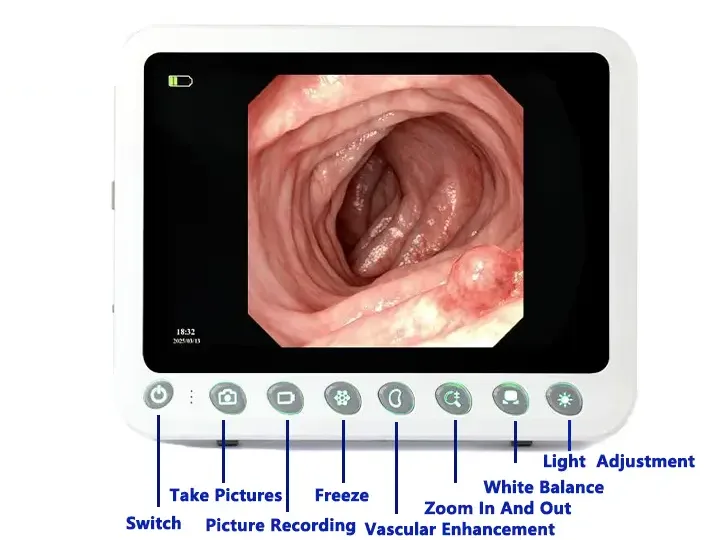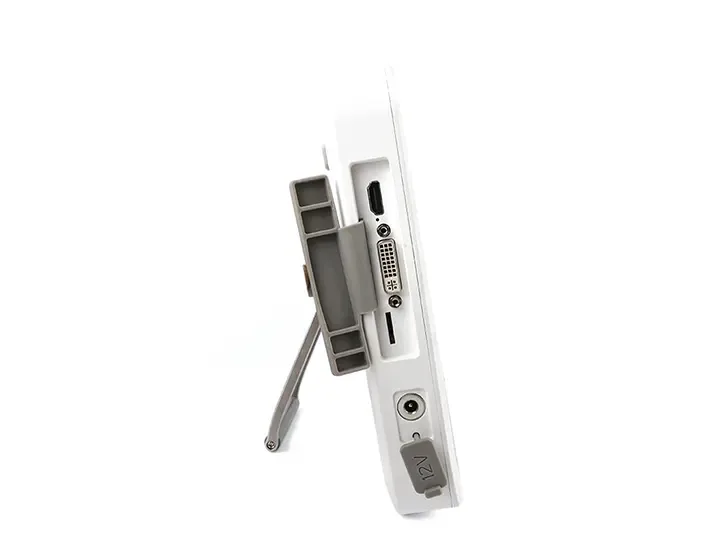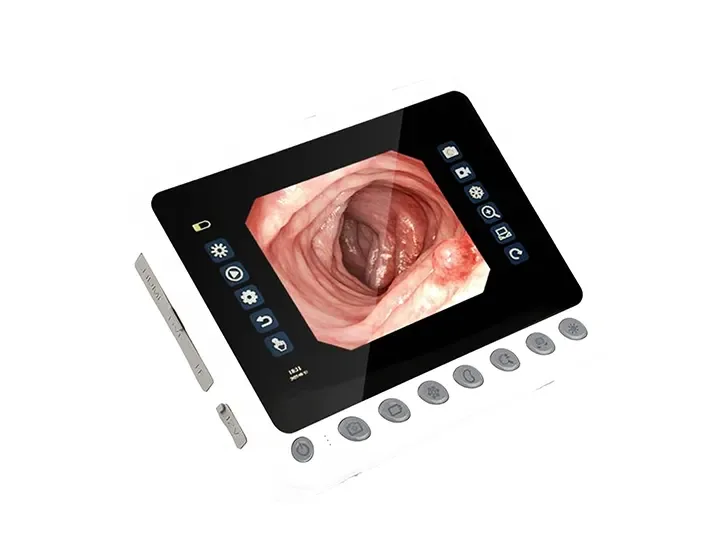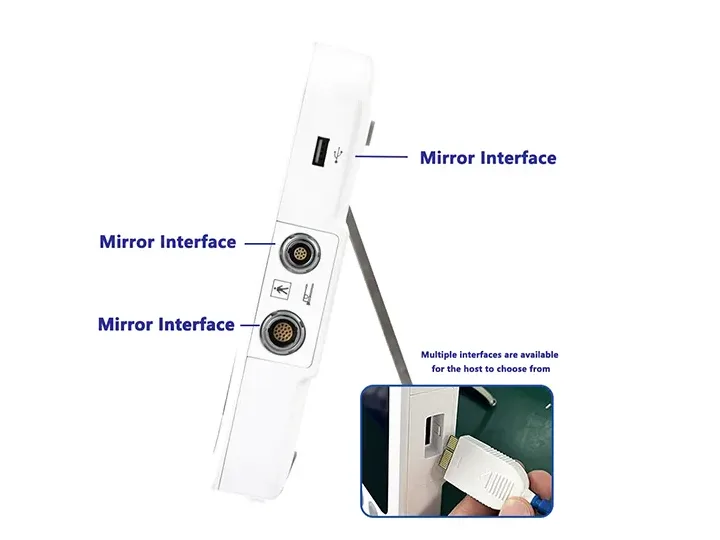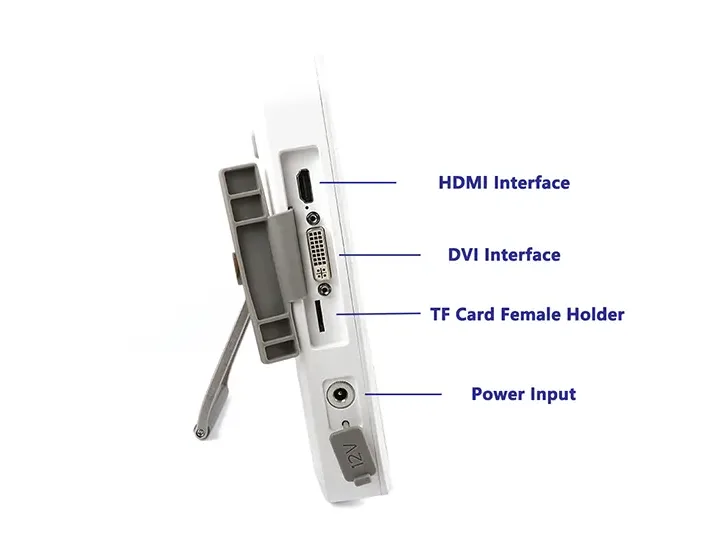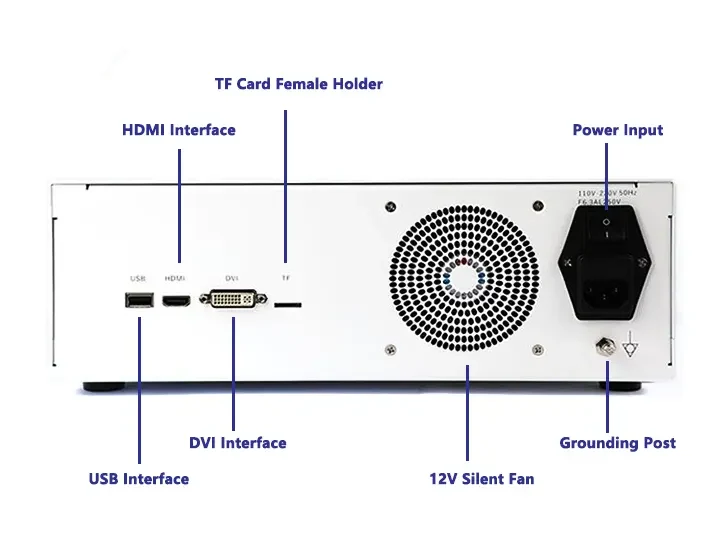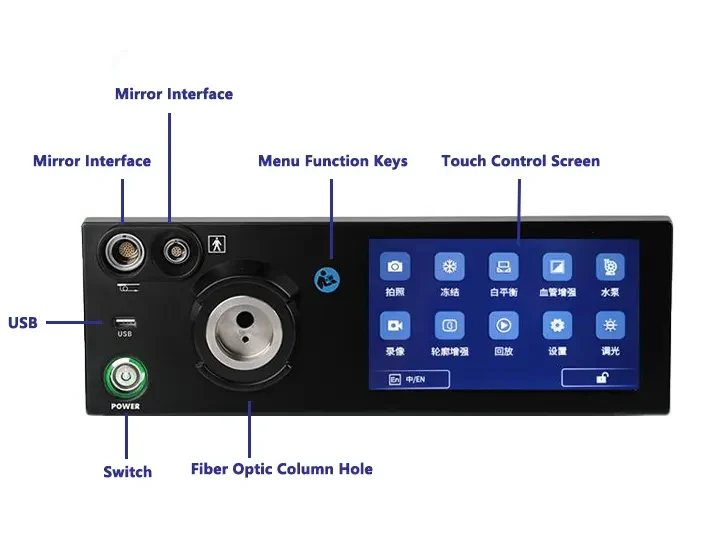The Endoscope Image Processor Portable Host is an advanced medical device designed to enhance diagnostic procedures in modern minimally invasive surgeries. With its compact and user-friendly design, this portable device provides high-resolution image processing for endoscopic examinations. This device is ideal for both clinical settings and remote or mobile healthcare services. It supports easy image capture and recording, allowing doctors to store and analyze visual data for accurate diagnoses. The Endoscope Image Processor Portable Host is perfect for various medical fields, including gastroscopy, bronchoscopy, and hysteroscopy. Its ability to zoom in and out and freeze images further improves diagnostic precision, ensuring a thorough examination of patients. Incorporating cutting-edge technology, this portable host is an indispensable tool for professionals seeking reliability and efficiency in their endoscopic procedures.
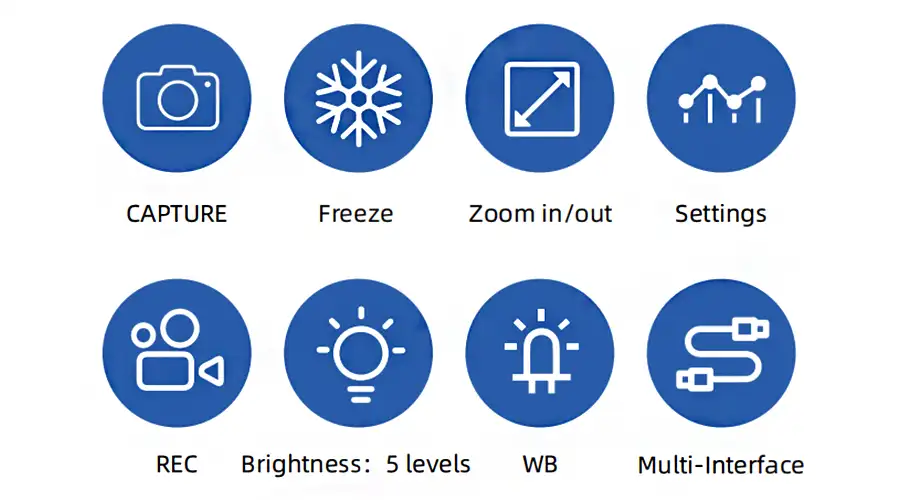
Wide Compatibility
Wide compatibility:Ureteroscope, Bronchoscope, Hysteroscope, Arthroscope, Cystoscope, Laryngoscope, Choledochoscope
Capture
Freeze
Zoom In/Out
Image Settings
REC
Brightness: 5 levels
WB
Multi-Interface
1280×800 Resolution Image Clarity
10.1" Medical Display,Resolution 1280×800,
Brightness 400+,High-definition
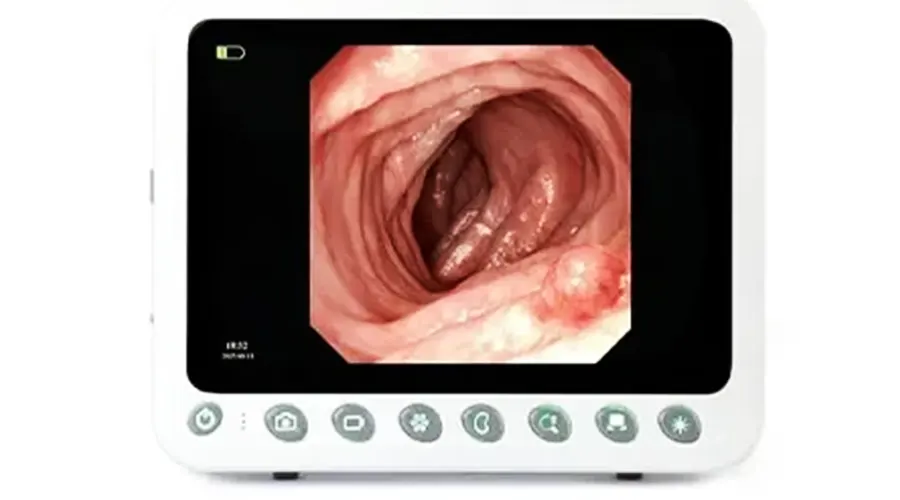
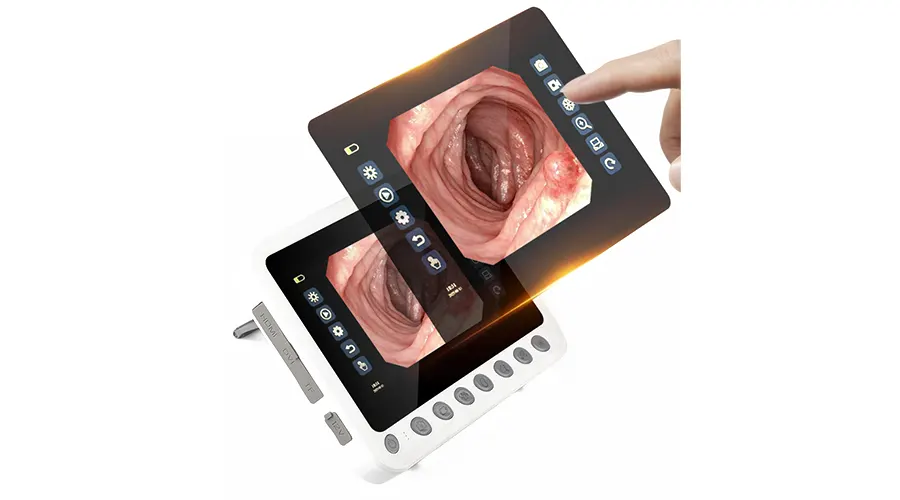
High-definition Touchscreen Physical Buttons
Ultra-responsive touch control
Comfortable viewing experience
Clear Visualization For Confident Diagnosis
HD digital signal with structural enhancement
and color enhancement
Multi-layer image processing ensures every detail is visible
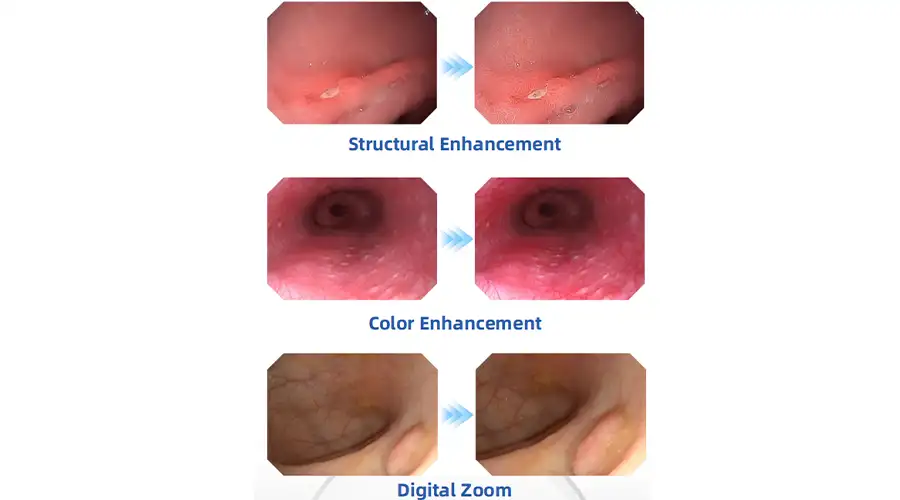
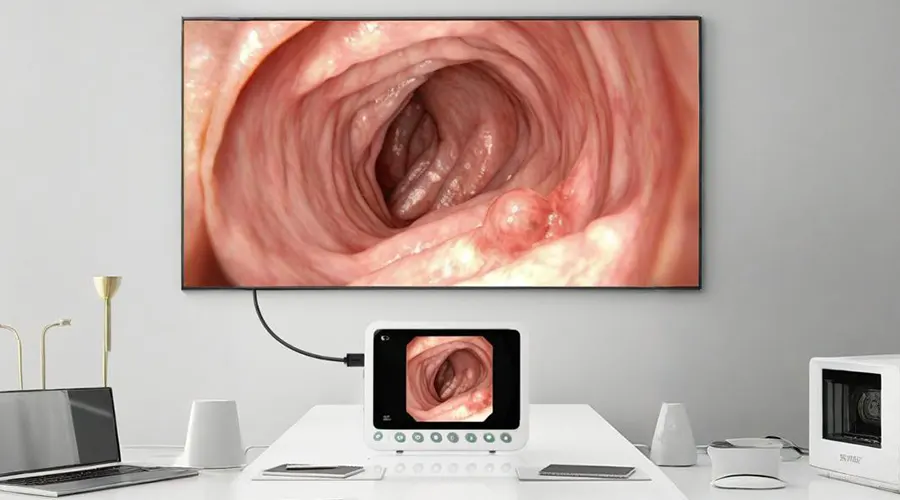
Dual-screen Display For Clearer Details
Connect via DVI/HDMI to external monitors - Synchronized
display between 10.1" screen and large monitor
Adjustable Tilt Mechanism
Slim and lightweight for flexible angle adjustment,
Adapts to various working postures (standing/sitting).
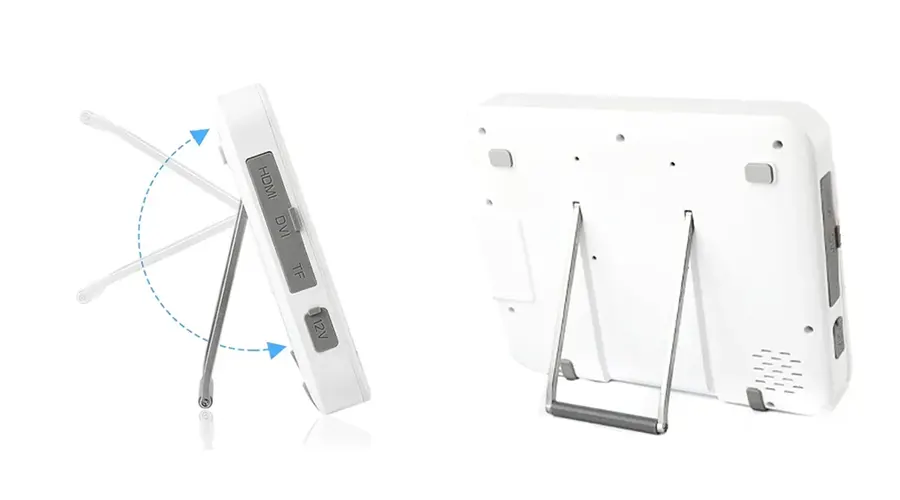
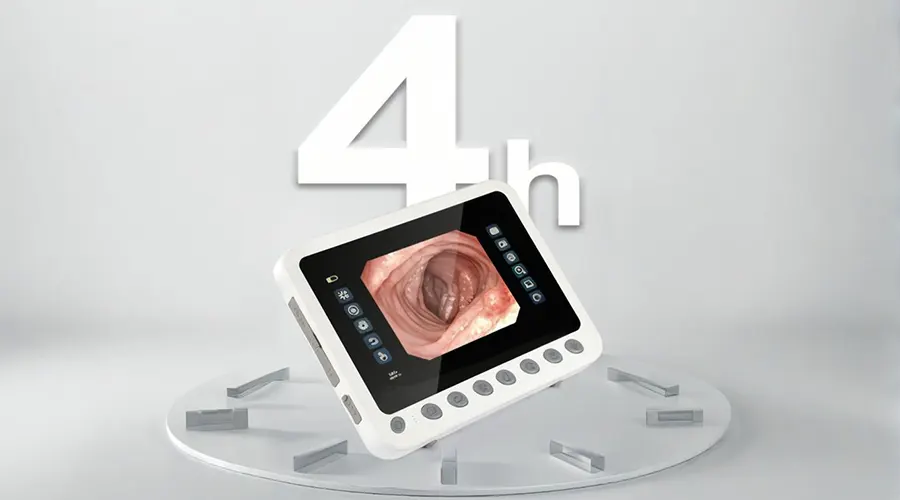
Extended Operation Time
Built-in 9000mAh battery,4+ hours continuous operation
Portable Solution
Ideal for POC and ICU examinations - Provides
doctors with convenient and clear visualization
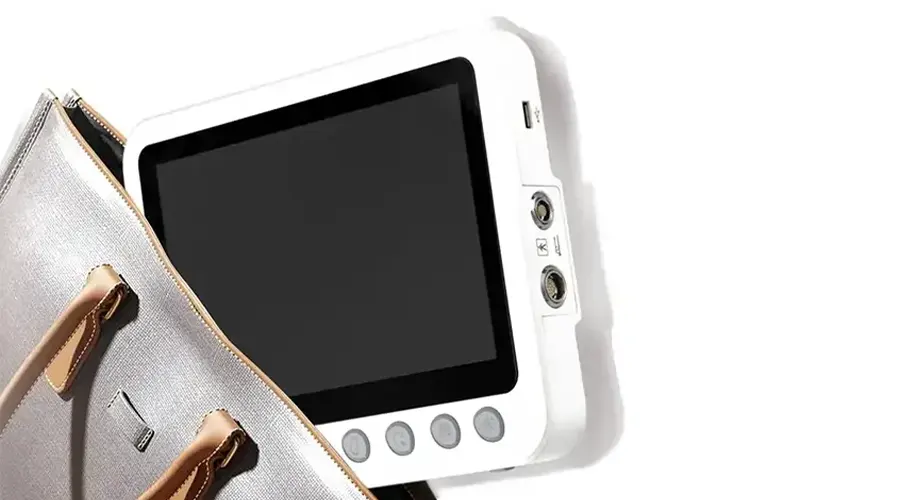

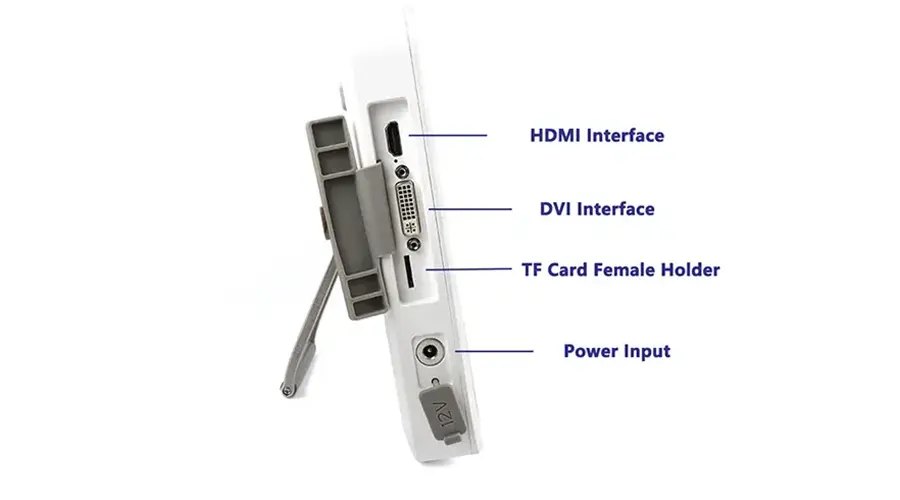
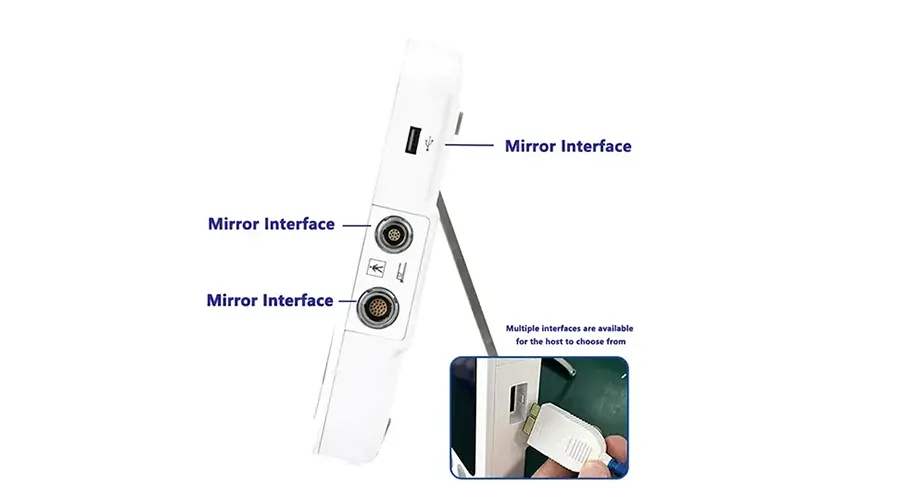
The portable endoscope image processor host is a revolutionary device in modern minimally invasive medical systems. It integrates the core functions of traditional large-scale endoscope image processing systems into portable terminals. As the "brain" of the endoscope system, the device is mainly responsible for:
Image signal acquisition and processing
Intelligent regulation of optical parameters
Medical data management
Cooperative control of treatment equipment
II. In-depth analysis of hardware architecture
Core processing module
Adopting heterogeneous computing architecture:
Main control chip: ARM Cortex-A78@2.8GHz (medical grade)
Image processor: dedicated ISP (such as Sony IMX6 series)
AI accelerator: NPU 4TOPS computing power
Memory configuration: LPDDR5 8GB + UFS3.1 128GB
Image acquisition system
Supports multiple interface inputs:
HDMI 2.0b (4K@60fps)
3G-SDI (1080p@120fps)
USB3.1 Vision (industrial camera protocol)
ADC sampling accuracy: 12bit 4 channels
Display output system
Main display: 7-inch AMOLED
Resolution 2560×1600
Brightness 1000nit (outdoor viewable)
Color gamut DCI-P3 95%
Extended output: supports 4K HDR external display
Power management system
Smart power supply solution:
Built-in battery: 100Wh (battery life 6-8 hours)
Fast charging protocol: PD3.0 65W
Backup power supply: supports hot-swap replacement
III. Core technical indicators
Image processing performance
Real-time processing capability:
4K@30fps full-process processing delay <80ms
Support HDR (dynamic range>90dB)
Noise reduction performance:
3DNR+AI noise reduction, SNR>42dB under low illumination
Optical control accuracy
Light source control:
LED drive current accuracy ±1%
Color temperature adjustment range 3000K-7000K
Auto exposure:
Response time <50ms
1024-zone matrix metering
AI processing capability
Typical algorithm performance:
Polyp recognition: >95% accuracy (ResNet-18 optimized version)
Bleeding detection: <100ms response time
Model update:
Support OTA remote model upgrade
IV. Software system architecture
Real-time operating system
Based on Linux 5.10 kernel customization
Real-time guarantee:
Image processing thread priority 99
Interrupt delay <10μs
Image processing pipeline
AI inference framework
Using TensorRT 8.2 acceleration
Typical model quantization scheme:
FP16 precision
INT8 quantization
Model pruning rate 30%
V. Clinical application performance
Improved diagnostic performance
Early gastric cancer detection rate comparison:
Device type Detection rate False negative rate
Traditional 1080p system 68% 22%
This device 4K+AI 89% 8%
Surgery efficiency indicators
ESD surgery time reduction:
Average reduction of 23 minutes (traditional 156min→133min)
Blood loss reduced by 40%
System stability
MTBF (mean time between failures):
Core components>10,000 hours
Complete machine>5,000 hours
VI. Comparative analysis of typical products
Parameters Stryker 1688 Olympus VISERA Mindray ME8 Pro
Processor Xilinx ZU7EV Renesas RZ/V2M HiSilicon Hi3559A
AI computing power (TOPS) 4 2 6
Maximum resolution 4K60 4K30 8K30
Wireless transmission Wi-Fi 6 5G Dual-mode 5G
Typical power consumption (W) 25 18 32
Medical certification FDA/CE CFDA/CE CFDA
7. Technology development trend
Next generation technology evolution
Computational photography technology:
Multi-frame synthesis (10-frame fusion)
Computational optics (wavefront sensing)
New display:
Micro OLED (0.5-inch 4K)
Light field display
System architecture innovation
Distributed processing:
Edge computing node
Cloud collaborative reasoning
New interconnection:
Optical communication interface
60GHz millimeter wave
Clinical function expansion
Multimodal fusion:
OCT+white light fusion
Ultrasound+fluorescence navigation
Surgical robot interface:
Force feedback signal processing
Submillimeter delay control
8. Use and maintenance specifications
Operation specifications
Environmental requirements:
Temperature 10-40℃
Humidity 30-75%RH
Disinfection process:
Disinfection method Applicable parts Cycle
Alcohol wipe Shell Each time
Low temperature sterilization Interface parts Weekly
Quality control
Daily test items:
White balance accuracy (ΔE<3)
Geometric distortion (<1%)
Brightness uniformity (>90%)
Maintenance cycle
Preventive maintenance plan:
Item Cycle Standard
Optical calibration 6 months ISO 8600-4
Battery test 3 months Capacity>80% initial value
Cooling system check 12 months Fan noise<45dB
IX. Market and regulatory status
Global certification requirements
Main standards:
IEC 60601-1 (safety regulations)
IEC 62304 (software)
ISO 13485 (quality management)
Typical application scenarios
Emergency scenarios:
Examination preparation time <3 minutes
Positive case detection rate increased by 35%
Primary medical care:
Equipment investment payback period <18 months
Physician training period shortened by 60%
Cost-benefit analysis
Life cycle cost comparison:
Cost item Traditional system Portable system
Initial investment $120k $45k
Annual maintenance cost $15k $5k
Single inspection cost $80 $35
X. Future Outlook
Technology integration direction
Combined with 5G/6G communication:
Remote surgery delay <20ms
Multi-center real-time consultation
Integrated with blockchain:
Medical data rights confirmation
Inspection record storage
Market development forecast
CAGR from 2023 to 2028: 28.7%
Key technology breakthroughs:
Quantum dot sensor
Neuromorphic computing
Degradable body material
Deepening clinical value
Integration of diagnosis and treatment:
Diagnosis-treatment closed loop
Intelligent prediction of prognosis
Personalized medicine:
Patient-specific model
Adaptive optical adjustment
This product represents an important direction for the development of endoscope technology towards intelligence and portability. Its technical characteristics and clinical application performance fully reflect the development concept of "miniaturization without reducing performance" of modern medical equipment. With the continuous evolution of technology, it is expected to play a greater role in primary care, emergency treatment and other fields.
Faq
-
Will portable image processors affect the imaging quality of endoscopes?
Using professional grade image processing chips, it can maintain high-definition image quality even in a portable size, ensuring diagnostic grade image output through real-time noise reduction and color enhancement.
-
Can this type of host connect multiple endoscopes simultaneously?
Most models support the simultaneous access of 1-2 endoscopes, enabling multi department collaboration through quick channel switching, but attention should be paid to bandwidth allocation to avoid lag.
-
How can portable processors cope with sudden power outages during surgery?
The built-in supercapacitor can maintain power supply for 30 seconds in case of power failure, ensuring emergency data storage. It is also equipped with a dual battery hot swappable design to ensure uninterrupted use.
-
How to handle the complex interfaces of the host during disinfection?
Adopting a fully enclosed waterproof interface design, combined with a dedicated dust cap, the surface can be directly wiped with alcohol to avoid liquid infiltration into precision circuit parts.
Latest articles
-
How XBX Cystoscope Supplier Ensures Quality and Precision for Hospital Procurement
Discover how the XBX Cystoscope Supplier provides hospitals with high-precision, OEM-ready endoscopy systems built for reliability, safety, and consistent imagi...
-
How XBX Bronchoscope Factory Delivers Reliable OEM Systems
Discover how the XBX Bronchoscope Factory ensures quality and reliability through advanced OEM manufacturing, optical precision, and strict quality control.
-
How XBX Laparoscope Minimizes Surgical Trauma in Abdominal Surgery
Discover how the XBX Laparoscope reduces surgical trauma through precision imaging, minimal incisions, and faster recovery in modern abdominal procedures.
-
How XBX Hysteroscope Detects and Removes Uterine Polyps
Discover how the XBX Hysteroscope enables precise detection and removal of uterine polyps, improving accuracy, safety, and comfort in women’s health care.
-
What Is an XBX Flexible Ureteroscope for Stone Removal?
Learn how the XBX flexible ureteroscope improves access, visibility, and efficiency in ureteral stone management with 4K imaging and ergonomic control.
Recommended products
-
Portable Hysteroscope Machine
The Portable Hysteroscope Machine (Portable Tablet Endoscope Host) delivers HD imaging and portability for hysteroscopy ...
-
XBX Portable medical endoscope host
The XBX Portable Medical Endoscope Host offers high-definition imaging for accurate diagnostics, wit
-
Gastrointestinal medical endoscope desktop host
Gastrointestinal medical endoscope desktop host provides 4K imaging for procedures, enhancing diagno
-
Gastrointestinal Endoscope Host
Gastrointestinal Endoscope Host provides 4K medical imaging for medical endoscopes, enhancing diagno

